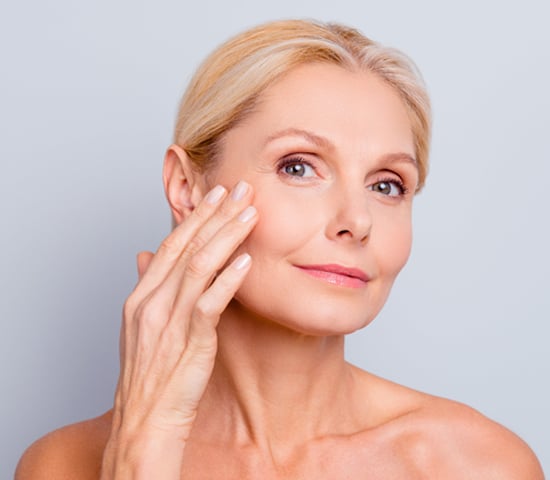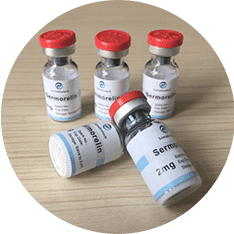
Unlock a More Youthful You With Hormone Replacemment Therapy In New Village, NJ
Aging is inevitable, and for many, it signals the beginning of a new chapter - one where you cross off bucket list items and live life to the fullest, on your own terms. However, for some women, aging is a horrible prospect, filled with chronic fatigue, irritability, and inability to perform in the bedroom. If you're concerned about life in middle age and beyond, we've got great news: there are easy, proven steps that you can take to help stop the negative effect of aging.
Global Life Rejuvenation was founded to give women a new lease on life - one that includes less body fat, fewer mood swings, and more energy as you age. If you're ready to look and feel younger, it's time to consider HRT (hormone replacement therapy), and growth hormone peptides. These therapies for men and women are effective, safe, and customized to fit your goals, so you can keep loving life as you get older.
HRT, and growth hormone peptide therapies bridge the gap between your old life and the more vibrant, happier version of you. With a simple click or call, you can be well on your way to a brighter future. After all, you deserve to be the one in charge of your wellness and health. Now, you have the tools to do so - backed by science and applied by our team of HRT experts with more than 13 years of experience.
What is HRT?
As women age, their hormones begin to go through changes that affect their day-to-day lives. For women, hormone deficiency and imbalance usually occur during menopause and can cause chronic fatigue, hot flashes, and mood swings, among other issues. Hormone replacement therapy helps correct hormone imbalances in women, helping them feel more vibrant and virile as they age.
Often, HRT treatments give patients enhanced quality of life that they didn't think was possible - even in their 60's and beyond.
The benefits for women are numerous and are available today through Global Life Rejuvenation.
HORMONE REPLACEMENT THERAPY
HRT and Anti-Aging Medicine for Women in New Village, NJ
As women age, their bodies begin to go through significant changes that affect their quality of life. This change is called menopause and marks the end of a woman's menstrual cycle and reproduction ability. Though there is no specific age when this change occurs, the average age of menopause onset is 51 years old. However, according to doctors, menopause officially starts 12 months after a woman's final period. During the transition to menopause, women's estrogen and other hormones begin to deplete.
As that happens, many women experience severe symptoms. These symptoms include:
- Hot Flashes
- Chronic Fatigue
- Incontinence
- Trouble Sleeping
- Dryness
- Muscle Loss
- Fat Gain
- Mood Swings
The symptoms of hormone deficiency can be concerning and scary for both women and their spouses. However, if you're getting older and notice some of these symptoms, there is reason to be hopeful. Hormone replacement therapy and anti-aging medicine for women can correct imbalances that happen during menopause. These safe, effective treatments leave you feeling younger, healthier, and more vibrant.


What Causes Menopause?
The most common reason for menopause is the natural decline in a female's reproductive hormones. However, menopause can also result from the following situations:
Oophorectomy: This surgery, which removes a woman's ovaries, causes immediate menopause. Symptoms and signs of menopause in this situation can be severe, as the hormonal changes happen abruptly.
Chemotherapy: Cancer treatments like chemotherapy can induce menopause quickly, causing symptoms to appear shortly after or even during treatment.
Ovarian Insufficiency: Also called premature ovarian failure, this condition is essentially premature menopause. It happens when a woman's ovaries quit functioning before the age of 40 and can stem from genetic factors and disease. Only 1% of women suffer from premature menopause, but HRT can help protect the heart, brain, and bones.
Common Issues for Women During Menopause
For many women, menopause is a trying time that can be filled with many hormonal hurdles to jump through. A little knowledge can go a long way, whether you're going through menopause now or are approaching "that" age.
Here are some of the most common issues that women experience during menopause:

Depression
If you're a woman going through menopause and find that you have become increasingly depressed, you're not alone. It's estimated that 15% of women experience depression to some degree while going through menopause. What many women don't know is that depression can start during perimenopause, or the years leading up to menopause.
Depression can be hard to diagnose, especially during perimenopause and menopause. However, if you notice the following signs, it might be time to speak with a physician:
- Mood Swings
- Inappropriate Guilt
- Chronic Fatigue
- Too Much or Too Little Sleep
- Lack of Interest in Life
- Overwhelming Feelings
Remember, if you're experiencing depression, you're not weak or broken - you're going through a very regular emotional experience. The good news is that with proper treatment from your doctor, depression isn't a death sentence. And with HRT and anti-aging treatment for women, depression could be the catalyst you need to enjoy a new lease on life.

Hot Flashes
Hot flashes - they're one of the most well-known symptoms of menopause. Hot flashes are intense, sudden feelings of heat across a woman's upper body. Some last second, while others last minutes, making them incredibly inconvenient and uncomfortable for most women.
Symptoms of hot flashes include:
- Sudden, Overwhelming Feeling of Heat
- Anxiety
- High Heart Rate
- Headache
- Nausea
- Dizziness
Typically, hot flashes are caused by a lack of estrogen. Low estrogen levels negatively affect a woman's hypothalamus, the part of the brain that controls body temperature and appetite. Low estrogen levels cause the hypothalamus to incorrectly assume the body is too hot, dilating blood vessels to increase blood flow. Luckily, most women don't have to settle for the uncomfortable feelings that hot flashes cause. HRT treatments for women often stabilize hormones, lessening the effects of hot flashes and menopause in general.

Mood Swings
Mood swings are common occurrences for most people - quick shifts from happy to angry and back again, triggered by a specific event. And while many people experience mood swings, they are particularly common for women going through menopause. That's because, during menopause, the female's hormones are often imbalanced. Hormone imbalances and mood swings go hand-in-hand, resulting in frequent mood changes and even symptoms like insomnia.
The rate of production of estrogen, a hormone that fluctuates during menopause, largely determines the rate of production the hormone serotonin, which regulates mood, causing mood swings.
Luckily, HRT and anti-aging treatments in New Village, NJ for women work wonders for mood swings by regulating hormone levels like estrogen. With normal hormone levels, women around the world are now learning that they don't have to settle for mood swings during menopause.

Weight Gain
Staying fit and healthy is hard for anyone living in modern America. However, for women with hormone imbalances during perimenopause or menopause, weight gain is even more serious. Luckily, HRT treatments for women coupled with a physician-led diet can help keep weight in check. But which hormones need to be regulated?
- Estrogen: During menopause, estrogen levels are depleted. As such, the body must search for other sources of estrogen. Because estrogen is stored in fat, your body believes it should increase fat production during menopause. Estrogen also plays a big part in insulin resistance, which can make it even harder to lose weight and keep it off.
- Progesterone: Progesterone levels are also depleted during menopause. Progesterone depletion causes bloating and water retention, while loss of testosterone limits the body's ability to burn calories.
- Ongoing Stress: Stress makes our bodies think that food is hard to come by, putting our bodies in "survival mode". When this happens, cortisol production is altered. When cortisol timing changes, the energy in the bloodstream is diverted toward making fat. With chronic stress, this process repeatedly happens, causing extensive weight gain during menopause.

Low Libido
Lowered sexual desire - three words most men and women hate to hear. Unfortunately, for many women in perimenopausal and menopausal states, it's just a reality of life. Thankfully, today, HRT and anti-aging treatments New Village, NJ can help women maintain a normal, healthy sex drive. But what causes low libido in women, especially as they get older?
The hormones responsible for low libido in women are progesterone, estrogen, and testosterone.
Progesterone production decreases during perimenopause, causing low sex drive in women. Lower progesterone production can also cause chronic fatigue, weight gain, and other symptoms. On the other hand, lower estrogen levels during menopause lead to vaginal dryness and even vaginal atrophy or loss of muscle tension.
Lastly, testosterone plays a role in lowered libido. And while testosterone is often grouped as a male hormone, it contributes to important health and regulatory functionality in women. A woman's testosterone serves to heighten sexual responses and enhances orgasms. When the ovaries are unable to produce sufficient levels of testosterone, it often results in a lowered sex drive.

Vaginal Dryness
Often uncomfortable and even painful, vaginal dryness is a serious problem for sexually active women. However, like hair loss in males, vaginal dryness is very common - almost 50% of women suffer from it during menopause.
Getting older is just a part of life, but that doesn't mean you have to settle for the side effects. HRT and anti-aging treatments for women correct vaginal dryness by re-balancing estrogen, progesterone, and testosterone. When supplemented with diet and healthy living, your vagina's secretions are normalized, causing discomfort to recede.

Fibroids
Uterine fibroids - they're perhaps the least-known symptom of menopause and hormone imbalances in women. That's because these growths on the uterus are often symptom-free. Unfortunately, these growths can be cancerous, presenting a danger for women as they age.
Many women will have fibroids at some point. Because they're symptomless, they're usually found during routine doctor exams. Some women only get one or two, while others may have large clusters of fibroids. Because fibroids are usually caused by hormone imbalances, hysterectomies have been used as a solution, forcing women into early menopause.
Advances in HRT and anti-aging medicine for women give females a safer, non-surgical option without having to experience menopause early. At Global Life Rejuvenation, our expert physicians will implement a customized HRT program to stabilize your hormones and reduce the risk of cancerous fibroid growth.

Endometriosis
Endometriosis symptoms are much like the effects of PMS, and include pelvic pain, fatigue, cramping, and bloating. While doctors aren't entirely sure what causes this painful, uncomfortable condition, most agree that hormones - particularly xenoestrogens - play a factor.
Endometriosis symptoms are much like the effects of PMS and include pelvic pain, fatigue, cramping, and bloating. While doctors aren't entirely sure what causes this painful, uncomfortable condition, most agree that hormones - particularly xenoestrogens - play a factor.
Xenoestrogen is a hormone that is very similar to estrogen. Too much xenoestrogen is thought to stimulate endometrial tissue growth. HRT for women helps balance these hormones and, when used with a custom nutrition program, can provide relief for women across the U.S.
Is HRT for Women the Right Answer?
Hormone stability is imperative for a healthy sex drive and for a normal, stress-free life during menopause. HRT and anti-aging treatments for women balance the hormones that your body has altered due to perimenopause or menopause.
HRT for women is a revolutionary step in helping women live their best lives, even as they grow older. However, at Global Life Rejuvenation, we know that no two patients are the same. That's why we specialize in holistic treatments that utilize HRT, combined with healthy nutrition, supplements, and fitness plans that maximize hormone replacement treatments.
If you've been suffering through menopause, is HRT the answer? That's hard to say without an examination by a trusted physician, but one thing's for sure. When a woman balances her hormone levels, she has a much better shot at living a regular life with limited depression, weight gain, mood swings, and hot flashes.
Here are just a few additional benefits of HRT and anti-aging treatments for females:


Benefits of HRT and Anti-Aging Medicine for Women in New Village, NJ
Hormone imbalance causes a litany of issues. But with anti-aging treatments for women, females can better process calcium, keep their cholesterol levels safe, and maintain a healthy vagina. By replenishing the body's estrogen supply, HRT can relieve symptoms from menopause and protect against osteoporosis. But that's just the start.
Global Life Rejuvenation's patients report many more benefits of HRT and anti-aging medicine for women:
- Fewer Mood Swings
- Thicker Hair
- Stronger Bones
- Less Body Fat
- More Energy
- More Stamina
- Increased Sex Drive and Pleasure Sensations
- Better Cognitive Functions
- Improved Pain Receptors
- Less Hot Flashes and Night Sweats
- Lower Triglycerides
- Fewer Bladder Infections
If you're ready to feel better, look better, and recapture the vitality of your youth, it's time to contact Global Life Rejuvenation. It all starts with an in-depth consultation, where we will determine if HRT and anti-aging treatments for women are right for you. After all, every patient's body and hormone levels are different. Since all our treatment options are personalized, we do not have a single threshold for treatment. Instead, we look at our patient's hormone levels and analyze them on a case-by-case basis.

HRT from Global Life Rejuvenation
At Global Life Rejuvenation, we help women rediscover their youth with HRT treatment for women. We like to think of ourselves as an anti-aging concierge service, guiding and connecting our patients to the most qualified HRT physicians available. With customized HRT treatment plan for women, our patients experience fewer menopausal symptoms, less perimenopause & menopause depression, and often enjoy a more youth-like appearance.
Reverse Aging with Growth Hormone Peptides
Growth hormone peptides are an innovative therapy that boosts the natural human growth hormone production in a person's body. These exciting treatment options help slow down the aging process and give you a chance at restoring your youth.

What is Sermorelin?
Sermorelin is a synthetic hormone peptide, like GHRH, which triggers the release of growth hormones. When used under the care of a qualified physician, Sermorelin can help you lose weight, increase your energy levels, and help you feel much younger.

Benefits of Sermorelin
Human growth hormone (HGH) therapy has been used for years to treat hormone deficiencies. Unlike HGH, which directly replaces declining human growth hormone levels, Sermorelin addresses the underlying cause of decreased HGH, stimulating the pituitary gland naturally. This approach keeps the mechanisms of growth hormone production active.
- Benefits of Sermorelin include:
- Better Immune Function
- Improved Physical Performance
- More Growth Hormone Production
- Less Body Fat
- Build More Lean Muscle
- Better Sleep

What is Ipamorelin?
Ipamorelin helps to release growth hormones in a person's body by mimicking a peptide called ghrelin. Ghrelin is one of three hormones which work together to regulate the growth hormone levels released by the pituitary gland. Because Ipamorelin stimulates the body to produce growth hormone, your body won't stop its natural growth hormone production, which occurs with synthetic HGH.
Ipamorelin causes growth hormone secretion that resembles natural release patterns rather than being constantly elevated from HGH. Because ipamorelin stimulates the natural production of growth hormone, our patients can use this treatment long-term with fewer health risks.

Benefits of Ipamorelin
One of the biggest benefits of Ipamorelin is that it provides significant short and long-term benefits in age management therapies. Ipamorelin can boost a patient's overall health, wellbeing, and outlook on life.
When there is an increased concentration of growth hormone by the pituitary gland, there are positive benefits to the body. Some benefits include:
- Powerful Anti-Aging Properties
- More Muscle Mass
- Less Unsightly Body Fat
- Deep, Restful Sleep
- Increased Athletic Performance
- More Energy
- Less Recovery Time for Training Sessions and Injuries
- Enhanced Overall Wellness and Health
- No Significant Increase in Cortisol
Your New, Youthful Lease on Life with HRT for Women
Whether you are considering our HRT and anti-aging treatments for women in New Village, NJ, we are here to help. The first step to reclaiming your life begins by contacting Global Life Rejuvenation. Our friendly, knowledgeable HRT experts can help answer your questions and walk you through our procedures. From there, we'll figure out which treatments are right for you. Before you know it, you'll be well on your way to looking and feeling better than you have in years!
 866-793-9933
866-793-9933
Request a Consultation
Latest News in New Village, NJ
How Transit Villages Are Reshaping New Jersey’s Urban Landscape
Marcelo Remondhttps://www.planetizen.com/blogs/125147-how-transit-villages-are-reshaping-new-jerseys-urban-landscape
The historic Central Railroad of New Jersey Terminal, Liberty State Park, Jersey City, New Jersey. | TTstudio / Central Railroad of New Jersey Terminal, Liberty State ParkAh, New Jersey, the state known for the Jersey Shore, pizza, and of course The Sopranos. The small state also happens to be the most ...
The historic Central Railroad of New Jersey Terminal, Liberty State Park, Jersey City, New Jersey. | TTstudio / Central Railroad of New Jersey Terminal, Liberty State Park
Ah, New Jersey, the state known for the Jersey Shore, pizza, and of course The Sopranos. The small state also happens to be the most densely populated in the country. Due to this, the Garden State has no shortage of thriving urban environments. Jersey City has been growing exponentially for the last several decades, and, along with Hoboken, has been nationally acclaimed for its great success in programs such as Vision Zero. But even though these cities are getting the spotlight, other towns in the state are making equally exciting progress in other topics.
Some background is necessary. Just like other older states, New Jersey possesses a traditional urban development pattern in several of its towns. One of the best examples of this traditional landscape is the famous streetcar suburb, a type of town that only came to exist due to train stations or streetcar lines nearby. The development followed transportation, creating dense communities around public transit. Yet like most of America in the mid-20th century, New Jersey started destroying its urban transit systems and ceding the landscape to the motor vehicle. Single-family homes and highways started to proliferate in the Garden State.
After decades of urban experimentation, a turning point occurred. It can be attributed in part to Jane Jacobs's masterpiece The Death and Life of Great American Cities, or maybe to the fact that authoritarian urban planning was just not popular; it does not really matter as they all had the same effect—a shifting urban design paradigm. Accordingly, a new movement began in the 1980s, known today as New Urbanism. The movement was founded on three main ideas: walkable blocks and streets, traditional neighborhood development (TND), and transit-oriented development (TOD).
This last item—paired with the fast development of issues such as climate change and the housing crisis (and their connection with the built environment)—spurred a call to action to solve our most concerning urban issues. Therefore, the urban landscape started being seen as something that could not be ignored and needed to change.
In 1990, New Jersey created an initiative called “The Transit Village,” with the main purpose of improving and revitalizing the surrounding areas of train stations. This would help the Garden State reduce gas carbon emissions by letting people live near the train station (and other amenities), and increase the number of housing units in downtowns across the state.
The initiative is simple enough. If a municipality gets the transit village designation, then the town is eligible for grants from the New Jersey Department of Transportation and can receive additional funding and technical assistance from state agencies. Additional resources, such as the Manual of Best Practices for Transit-Oriented Development, are always available and further help towns expand on their plans. Most of this does not come for free, however. According to the New Jersey Department of Transportation, towns can only be designated as Transit Villages if “These municipalities have demonstrated a commitment to revitalizing and redeveloping the area around their transit facilities into compact, mixed-use neighborhoods with a strong residential component.” Also, towns must comply with formal criteria and an application process.
This is not to promote bureaucracy or slow progress but to further ensure that the money and time spent are going to municipalities committed to improving their residents’ quality of life. In other words, the initiative is not for municipalities trying to get some extra capital for not-related projects, or who have not embraced New Urbanist thinking.
The program started with only five towns. Now, more than 30 towns are designated as Transit Villages, with Atlantic City being the latest addition, becoming the 35th member of the initiative. The program has achieved incredible progress on its mission of making areas near train stations more attractive. According to a special report from New Jersey Future by research director Tim Evans, “Transit station neighborhoods went from accounting for a meager 2.3 percent of total statewide population growth from 2000 to 2007 to accounting for a remarkable 38.3 percent of statewide growth from 2008 to 2012 ” (p.2). This means that in just over a decade, the urban growth in TODs has increased by nearly twentyfold. This shift towards transit-oriented lifestyles reflects the changing preferences of residents who are seeking the benefits of living in walkable, well-connected communities.
These changing preferences continue to trend in a positive direction. In an email exchange on August 7, 2023, Evans stated “There are 153 municipalities that host at least one transit station (rail, ferry, or major bus terminal). Those municipalities accounted for 70.8% of total statewide (NJ) population growth between 2010 and 2020, compared to only 27.8% of the state total between 2000 and 2010.” Even though this signals a broader trend (as this figure was at the municipal level and not specifically near transit stations), this shows the growing demand for walkable and transit-friendly spaces. Moreover, this data suggests the potential benefits that the Transit Village initiative could offer to numerous other towns across the state.
One New Jersey town that could rapidly benefit from these changes is Iselin. Iselin possesses the fourth busiest train station in the state, Metropark. With direct access to New York City through NJ Transit’s Northeast Corridor and Amtrak lines that go as far as Washington D.C., the station sees movement all day long. When Metropark was built, it was planned for suburbanites who would drive from their single-family homes to the train station. Thus, giant parking decks were constructed, occupying most of the space. But in 2022, the future seemed a little brighter. Under a new plan, this station would convert from a park-and-ride into a prospering transit-oriented development. The concept calls for 230 to 250 housing units and 250,000 square feet of office space with ground-level retail. This would completely transform the suburban nature of Iselin into a more diverse environment, creating a prosperous transit-oriented development where people can live, eat, work, and access transportation without a car. Towns like this can then could opt for a Transit Village designation, which could further build on the potential of the TOD. For instance, it could create a better connection to downtown, which at the moment is separated by the high-speed, four-lane Lincoln Highway and further complicated by a lack of sidewalks.
All of this new growth in transit-oriented villages also means a win for the fight against climate change. According to a series of articles from the Land Use Law Center at Pace University, “Transit-Oriented Development increases climate-resilient development by reducing greenhouse gasses and the amount of land necessary to accommodate a growing population and economy.” And it makes sense—when analyzing the population growth, it can be appreciated that despite the fact that the 153 municipalities represent less than half of the total New Jersey 565 municipalities/towns, they still managed to account for 70.8 percent of the total statewide population growth! It is clear that transit-friendly villages are synonymous with efficient land use.
The program has helped undo the terrible damage done to our downtowns in the past. Visibly significant undertakings, such as the transformation of parking lots into mixed-use developments, are just the surface of the Transit Village initiative’s achievements. Just take a look at another New Jersey town, Bloomfield. Less than two decades ago, most of the land near the century-old Bloomfield Station was parking lots. In 2023, the town redeveloped two parking lots near the train station into thriving mixed-use developments, and two more mixed-use developments are in the works. Now, thanks to the Transit Village Initiative, Bloomfield’s residents can easily live, shop, exercise, dine, and take the train within a radius of less than 0.2 miles.
Another great example can be found in Cranford, also a town with a historic train station. In 1997, Cranford Township was struggling to improve and rehabilitate its downtown. Despite a $3 million investment and a previous designation as a special improvement district, the magical moment had still not happened. The problem—as it was then shown in a commissioned report by Danth Inc.—was the suburban development pattern of Cranford’s downtown. Things needed to change. Accordingly, Cranford adopted the Transit-Friendly Village designation in 2003. Local officials knew that the train station needed to be the focus of the town. Since then, mix-used developments have been constructed in front of the station, with more planned for the future in other areas. The decision of challenging the status quo resulted in a vibrant downtown and thriving community.
It then can be said that thanks to the Transit Village initiative, more New Jerseyans have a chance to experience urban life. People in Bloomfield and Cranford are better off now than they were 15 to 20 years ago, and are enjoying the benefits of TOD. The program showed that demand for density was always there, it just needed the right vision and planning to flourish. At the same time, the initiative serves as a vital tool in the fight against climate change and the housing shortage by creating more efficient land use patterns. This success story serves as an example for other states who face similar issues and signals that the policies of the past, however ingrained, are not permanent. Most importantly, it shows that change is possible—and that it is already happening.
Land Use Transportation Urban Development New Jersey Transit Village View More
6 Abandoned and Forgotten Ghost Towns in New Jersey
Nixza Gonzalezhttps://a-z-animals.com/blog/abandoned-and-forgotten-ghost-towns-in-new-jersey/
Ghost towns aren’t just limited to the wild west. They are also common in northern states, like New Jersey. Many New Jersey ghost towns, though, are difficult to find. Only a few buildings, if any, remain in many of these deserted and forgotten spots.Follow along to discover 6 abandoned and forgotten ghost towns in New Jersey.Batsto VillageStarting our list of ghos...
Ghost towns aren’t just limited to the wild west. They are also common in northern states, like New Jersey. Many New Jersey ghost towns, though, are difficult to find. Only a few buildings, if any, remain in many of these deserted and forgotten spots.
Follow along to discover 6 abandoned and forgotten ghost towns in New Jersey.
Batsto Village
Starting our list of ghost towns in New Jersey is the Batsto Village. It’s one of the easiest ghost towns to visit in the state. This deserted town is certainly not forgotten. It’s a historical unincorporated community with many remaining old and fascinating buildings. Basto Village first began to grow in 1766, when Charles Read built the Batsto Iron Works along the Batsto River. This Iron Works successfully produced household items like pots and pans. The ghost town truly expanded in the 1800s when families moved to find work. When the iron industry declined, Batsto Village relied on glass-making.
Now, you can visit this historical site, which is listed on the National Register of Historic Places. Guided tours are available, which include the Batsto Mansion and the Atsion Mansion. The visitor center hosts an informational museum and a beautiful exhibit gallery. Events are also held in the Batsto Village, like the Country Living Fair.
Ong’s Hat
Not much remains of Ong’s Hat (or Ong’s Hut, depending on which legend you believe). Although a ghost town, it’s not forgotten! Ong’s Hat has a long history. Although historians aren’t sure when the village got its name, it’s older than the revolutionary war. This name appears in a 1778 map of Hessian encampments in New Jersey. The town’s peak may have been in the 1860s. However, by the 1930s, while the town’s name remained on maps, there was nothing there but a few brick remains, an open clearing, and an abandoned shed. Some historians aren’t sure if Ong’s Hat was ever a real village. Today, it is a terminus of the Batonia Trail, one of the longest in the state.
If you think Ong’s Hat is strange, you aren’t the only one. According to a conspiracy theory-based story dating back to the 1980s, a group of scientists travels to a creepy parallel universe from Ong’s Hat. One of the core writers/storytellers wrote a book titled, The Incunabula Papers: Ong’s Hat And Other Gateways To New Dimensions. Although he stated that this work was pure fiction, some people believe that Ong’s Hat is part of a bigger conspiracy.
Feltville
Next on our list of ghost towns in New Jersey is Feltville. Like Batsto Village, Feltville is relatively well-known. Many buildings remain in this abandoned ghost town. Although almost completely abandoned except for three families, Fetlville is now Feltville Historic District. Another name for this village/site is the Deserted Village.
Although the town/village was built in 1825, the first European settler moved to the area in 1736. Peter Willcox, the first settler, built a sawmill, but its days were limited. It was demolished as the population of the area grew. A century after Peter Willcox moved to the area, David Felt purchased land from Willcox’s ancestors and built a mill on Blue Brook, two dams, and a village for workers. Although successful under David Felt, he sold the land to different businesses, that eventually left the area and the buildings abandoned. One of these businesses was a summer resort.
Allaire Village
Another New Jersey ghost town is Allaire Village. Although a ghost town, it’s also a living history museum. You can find this interactive museum in Allaire State Park. Long before European settlers came to the area, the land under the village was an Indian ceremonial ground.
The village was built in 1750. One of the first settlers was Issac Palmer. However, the village is named after James P. Allaire, who purchased the land in 1822. At the village’s peak, it was home to about 500 people. However, the village’s success declined drastically after the wood-burning furnace business collapsed. Although mostly left abandoned after the late 1800s, some buildings were used by passing residents. The village was also used as a backdrop for a few silent movies.
Waterloo Village
Waterloo Village is a historic site in Stanhope, New Jersey. This village is called the Waterloo Village Historic Site. It’s open to the public, with tours available Saturdays and Sundays between June and September. Not only can you visit this historic site to learn more about the village and its buildings, but also hike surrounding nature trails.
Waterloo Village was built in 1820. Its location about halfway along the Morris Canal made it a convenient stopover and service center. This 19th-century ghost town is located on about 70 acres of land. This open-air museum is on the National Register of Historic Places. Buildings that remain standing include Smith’s General Store, the Blacksmith Shop, Peter D. Smith House, Smith Homestead House, and the United Methodist Church.
Walpack Center
Last but not least is the Walpack Center. It’s an unincorporated community in the much larger Walpack Township. This ghost town was previously a farming community built in the 1800s. Although not completely abandoned, it declined tremendously during the 1900s as larger cities grew around this community. You can visit the Walpack Center Historic District to see old buildings like a small schoolhouse built in 1856.
Summary of 6 Abandoned and Forgotten Ghost Towns in New Jersey
The photo featured at the top of this post is © Wangkun Jia/Shutterstock.com
Final Plans for a New Ablett Village Going to Camden Planning Board
NEILL BOROWSKIhttps://www.tapinto.net/towns/camden/sections/development/articles/final-plans-for-a-new-ablett-village-going-to-camden-planning-board
CAMDEN, NJ – When a project to demolish and replace the 81-year-old Ablett Village goes before the Camden Planning Board on August 31, it will be the largest piece of an overall $150-million project that is transforming public housing in the Cramer Hill section.The Michaels Organization, the Camden-based developer leading the project, will present the board with proposals for final site plans for both phases of the Ablett Village project.That project calls for constructing 12 new buildings containing 78 new townhomes in t...
CAMDEN, NJ – When a project to demolish and replace the 81-year-old Ablett Village goes before the Camden Planning Board on August 31, it will be the largest piece of an overall $150-million project that is transforming public housing in the Cramer Hill section.
The Michaels Organization, the Camden-based developer leading the project, will present the board with proposals for final site plans for both phases of the Ablett Village project.
That project calls for constructing 12 new buildings containing 78 new townhomes in the first phase and 18 new buildings containing 144 new townhomes in the second phase.
Sign Up for FREE Camden Newsletter
Get local news you can trust in your inbox.
This site is protected by reCAPTCHA and the Google Privacy Policy and Terms of Service apply.
Ten of the existing Ablett Village buildings would be demolished in the first phase; the remaining ones would be taken down in the second phase.
The second phase includes building a community center, playground, community garden, café area and computer lab all in the middle of the new development, Nicholas J. Cangelosi, senior vice president of development for Michaels, told TAPinto Camden in an interview.
Both phases of the Ablett Village project account for between $80 million and $90 million of the overall project, which includes townhomes built elsewhere in Cramer Hill and an age-restricted apartment building. Many of the residents of the townhomes and apartments are permanently relocated Ablett Village residents.
The overall project this summer opened 75 new rental townhomes at three different locations. The townhomes all are occupied today, Cangelosi noted. Most of the townhomes neighbor the Veterans Memorial Family School with others on Harrison Avenue across from the Salvation Army Camden Kroc Center.
In addition, the 55-unit apartment building for seniors now under construction at North 24th Street and Pierce Avenue is scheduled to be finished in December, Cangelosi said.
The apartment building will include a health and wellness center for its residents and will be programmed by Virtual Health and the Rutgers-Camden School of Nursing, he added. Two exam rooms will accommodate physical exams and other health and wellness services.
Incorporating health services with senior-citizen housing is a growing trend. The Michaels Organization is developing a new 47-unit apartment building for seniors on Davis Street at the end of the parking lot at the Ferry Avenue PATCO station. That building will contain a larger Virtua neighborhood health center, with 14 examination rooms.
The Camden Housing Authority owns the land for the Cramer Hill projects and the authority and Michaels Organization jointly own the buildings, according to Cangelosi. Nearly all the units will be affordable, with a few market-rate rentals.
Michaels will manage the properties, with the authority overseeing the rental waiting list and rental assistance. The authority now manages Ablett Village.
South Orange Board of Trustees Appoints New Village Administrators
Fred Smithhttps://www.tapinto.net/towns/soma/sections/government/articles/south-orange-board-of-trustees-appoints-new-village-administrators
SOUTH ORANGE, NJ - The South Orange Board of Trustees unanimously appointed two new village administrators during its April 25 meeting, promoting from within to select two dedicated village employees.Julie Doran, who previously held the temporary position of acting village administrator, was permanently installed into the village administrator role. Recreation and Cultural Affairs director Peter Travers was selected as deputy village administrator.Doran, a former marketing executive who worked with the board of trustees to prom...
SOUTH ORANGE, NJ - The South Orange Board of Trustees unanimously appointed two new village administrators during its April 25 meeting, promoting from within to select two dedicated village employees.
Julie Doran, who previously held the temporary position of acting village administrator, was permanently installed into the village administrator role. Recreation and Cultural Affairs director Peter Travers was selected as deputy village administrator.
Doran, a former marketing executive who worked with the board of trustees to promote local businesses before stepping into the role of deputy village administrator two years ago, was given a glowing recommendation by the board. Trustees spoke of Doran’s record of excellent public service for the village of South Orange, and her determination to always do good for the residents of the town she represents.
Sign Up for FREE SOMA Newsletter
Get local news you can trust in your inbox.
This site is protected by reCAPTCHA and the Google Privacy Policy and Terms of Service apply.
“I’ve been on team Julie since the beginning,” Trustee Bill Haskins said. “When people look back years from now at what this town is, Julie Doran is going to be a name that people talk about. We know she is a brilliant mind, but she does everything leading from the heart as well. That’s what makes her a great person for South Orange going forward.”
Doran was similarly praised for her transparency with the people of South Orange, always making sure the public was aware of upcoming projects and the impact they would have on the community.
Village President Sheena Collum said that Doran always acts with understanding and kindness in her role, and that her attitude demonstrates how all government employees should carry out their work.
“Julie, I just love you so much, I really do!” Collum said. “It goes beyond just your exceptional talent. The way you treat our residents is indicative of what the board of trustees wants for every interaction with our government to reflect: with empathy and compassion for finding solutions. It’s a hard position and you do it so gracefully. There is nothing more in a village administrator that I could want than everything you offer us. I am the happiest village president in the history of village presidents!”
The new deputy village administrator, Peter Travers, was given similar high praise and well wishes for his new role. Travers, director of Recreation and Cultural Affairs, began his career for the village at the age of 14, when he worked part-time doing seasonal maintenance in the rec department. Trustees said it was inspiring to see someone work their way up through the ranks of local government.
“A lot of the people in this community have watched you grow up,” Collum said. “You’re going to be spectacular. If there’s anything, we love promoting from within. And it’s great to see somebody move through the ranks and succeed.”
Travers was also lauded for his handling of the recreation department, which he successfully navigated through pandemic-era challenges. According to the board, the recreation department took the biggest financial hit during the pandemic. But thanks to Travers’ leadership, and a pivot to digital work, recreation came out of the pandemic in good standing.
Trustee Stephen Schnall credits Travers’ unrivaled knowledge of the village and the people in it with his ability to overcome obstacles like the pandemic.
“Pete knows this town like nobody else,” Schanll said. “That knowledge and experience can’t be taught. Knowing what the community likes and what they don’t like is something that Pete was able to bring to his job every day. I’m just so excited and proud to now have him as our deputy village administrator.”
Travers was grateful to the board for his appointment, and for the opportunity to continue serving the town that had taught him so much.
“I do feel like I’ve grown up so much working for the town of South Orange, and the support that the board has thrown behind me as well support from my colleagues has been instrumental in getting me here,” Travers said. “I look forward to working with the team as we go forward and continuing to make improvements where we can.”
TAPinto SOMA is a free online newspaper serving the Townships of Maplewood and South Orange Village with no paywall. TAPinto SOMA is accredited by the New Jersey Press Association, and is a locally owned news organization serving the community.
Are you a business owner looking to reach our audience? Please reach out to us at [email protected] for information about our digital marketing packages.
Don’t miss important news in SouthOrange/Maplewood. Click HERE to subscribe for free, or follow us on Facebook and on Twitter at @TAPintoSOMA.
Farewell, Liberty Village: Nation’s oldest outlet mall is a ‘ghost town’ in final shopping days
Camille Fursthttps://www.nj.com/news/2022/12/farewell-liberty-village-nations-oldest-outlet-mall-is-a-ghost-town-in-final-shopping-days.html
For decades, the beloved brick walkways winding through the outlets at Liberty Village in Hunterdon County were a destination for shoppers in the days leading up to Christmas and Hanukkah.The outdoor mall — founded as the nation’s first major outlet center in the 1980s — drew shoppers from around New Jersey, Pennsylvania and New York.On...
For decades, the beloved brick walkways winding through the outlets at Liberty Village in Hunterdon County were a destination for shoppers in the days leading up to Christmas and Hanukkah.
The outdoor mall — founded as the nation’s first major outlet center in the 1980s — drew shoppers from around New Jersey, Pennsylvania and New York.
Only three stores in the roughly 23-acre complex — the Ann Taylor Outlet, the Polo Ralph Lauren Factory and Brooks Brothers — remain open. Though it was only a few days before Christmas, not a single shopper was anywhere in Liberty Village on Dec. 15.
“People weren’t shopping at it,” said Flemington Mayor Betsy Driver. “The stores have been closing, the retail market has been changing and it’s now basically a ghost town.”
Two Ann Taylor Outlet employees said on Dec. 15 they’ve still been busy on weekends, but business on weekdays has slowed down. The shop is slated to stay open through January, then move to another location in Flemington.
When it opened in 1981, Liberty Village was considered the nation’s first major outlet shopping center. It enjoyed enormous success and expanded in the late 1990s, but has since declined amid a lack of visitors.
Flemington Borough officials declared it an area in need of redevelopment in Dec. 2021, Driver said. The borough council adopted a redevelopment agreement last year with the Hoboken Brownstone Company, a real estate firm based in Hudson County.
George Vallone, owner of Hoboken Brownstone, plans to redevelop the site into mixed-income housing units, he said. The borough council adopted an agreement with Vallone last year, making him the outlet mall’s designated redeveloper, Driver said.
Vallone said he’s getting the property ready for demolition, which he hopes to start by the spring of next year.
He used to go to Liberty Village with his family “all the time,” he said. “It was phenomenal. Literally thousands of people went there.”
At its peak, the outlet mall was assessed to be worth $33 million, Vallone said. Now the property is assessed to be worth $3 million, only 10% of what it was in its heyday, he added.
Vallone plans to redevelop the property into 164 townhomes, three group homes and a set of apartments. It will also include a 7,500-square-foot park and a town hall, which the company will donate to the borough.
Veterans and adults with disabilities will occupy the group homes, he said. The property will also have 27 affordable housing units.
The redeveloped property will “lower the tax burden on all the other taxpayers” in the borough, he said.
The plan is to have construction of the townhomes and group homes, part of the redevelopment’s first phase, complete by 2027.
Disclaimer:


